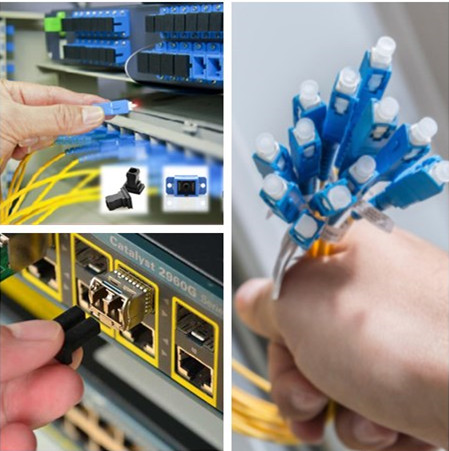What is the main purpose of fiber optic connector dust caps? To protect the connector end-face from dust? Not absolutely! Actually, a dust cap might also introduce dust and other contaminants to the polished end-face of a fiber optic connector in some cases. Then why use those fiber optic dust caps and what should be noticed when using them? This article will give you the answer.
Dust is everywhere. Smaller dust particles that have a diameter of 1um or less can remain suspended in air for a very long time. Dust can easily find its way into a dust cap, and stow away until it has the opportunity to jump aboard your fiber optic connector end-face. Dust caps do a great job in protecting fiber optic connector end-faces from contact with objects that can scratch, chip, crack or otherwise physically damage the polished core of the fiber. Dust caps also provide ferrule protection and are ideal for protecting connectors from physical damage while in storage or in transit. If you accidentally drop a connector that's wearing a dust cap, chances are it will survive the fall. It is advisable to install dust caps on any fiber optic connector that is not actively in use.
Dust caps can be purchased alone, and some fiber optic connectors come with protective caps already installed. Typically, the cap is a sleeve or boot that is closed at one end and which fits tightly over the ferrule of the fiber optic connector.
As mentioned above, almost all ports in fiber systems need dust caps to protect from damage or external contaminates when they are unused. Fiber optic adapters, connectors and fiber transceivers are the most commonly used optics in fiber system that need dust caps. These types of fiber optic dust caps are respectively called adapter dust caps, connector dust caps and transceiver dust caps.
- Adapter Dust Caps – Used for protecting fiber adapters and couplers.
- Transceiver Dust Caps – Also called port dust cover, are usually inserted into the optical ports of unused transceiver modules.
- Connector Dust Caps – Used for protecting the ferrule of fiber optic connectors or the connectors on a fiber patch cord.

Besides, according to the materials, there are plastic dust caps and metal duct caps. Plastic dust caps are much cheaper than the metal counter-parts. Metal dust caps may also be made to shield against EMI issues. But notice that many styles of metal dust covers also come with an attached chain which may be secured to the chassis. Using the chain insures that the dust cover is not dropped or lost when disconnected for cable attachment. And depending on the using targets, adapter and connector dust caps can also be divided into LC, SC, ST, FC, etc.
Fiber optic dust caps are necessary for fiber optic connectors, adapters and unused transceiver ports, especially for protecting from physical damage while in storage or in transit. When the fiber optic components are not in use, the dust caps are also with the dust-proof function to some extent. However, it doesn’t mean that they can completely isolated the contaminates. Quite the opposite, dust caps are one of the contaminant sources in fiber systems. Dust is everywhere, it can easily find its way into a dust cap and the inside of the dust cap can actually have significant dirt or other contaminates that are easily transferred to the contact’s end face. In addition, some inferior dust caps often contain grease, gels or other compounds left over from when they were manufactured. For these reasons, some people think that “dust cap” is a misnomer.
But unfortunately, most of the users are not aware of it. They think that the fiber optic dust caps ensure the end face clean and ready to use. Thus they can remove the dust cap and plug it in directly without any cleaning, which results in additional loss incurred at the optical interface. If you find your fiber systems are not operating normally, it is better to check whether you have done the proper cleaning before connecting. Don’t neglect this small issues as it may cause an error to your fiber system.
Fiber optic dust caps, as commonly used fiber optic consumables are necessary for fiber systems. However they may also become contaminates in some cases. Thus, the proper inspection and cleaning of fiber end faces is critical to the performance and life of any fiber system. Fiber optic dust caps can be purchased alone, and some pre-terminated fiber assemblies come with dust caps pre-installed. As the main supplier for fiber optical products in China, FS.COM offers a wide range of fiber optic duct caps for transceivers, connectors, adapters, etc. Besides, high-quality transceiver modules are also available for your choice, among which there are FCLF-8521-3 1000BASE-T SFP, FTLF1318P3BTL 1G Fibre Channel SFP and so on.









